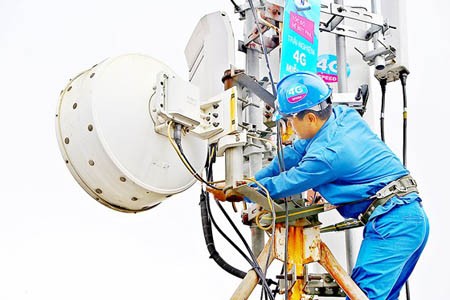
Cheap, but only theoretically
Until May 2018, there were around 76.8 million Internet users in Vietnam, 64.2 million of whom access it via broadband, including 51.2 million 3G subscribers and 13 million 4G ones.
At the moment, in the domestic market, hundreds of data packages are offered by various network providers, with the price ranging from tens to hundreds of thousands VND (approx. $1 – 40) for 30 days. Some such examples are the MIMAX70 package of Viettel with 3GB of data per month for VND70,000 ($3), or the MAX package of VinaPhone and the HD70 package of MobiFone with 3.8GB per month for the same fee.
There are also some combination packages, a result of the cooperation between mobile network and online service providers like Facebook or YouTube. These products are more attractive with 30GB of high-speed data per month for around VND300,000 ($13).
Another popular product is a data Subscriber Identity Module (SIM), with 2GB of data per day for VND90,000 ($3.8) per month.
The fact is, however, users who only need to perform basic functions like sending and receiving emails, watching videos, and accessing popular applications such as Facebook, Over-the-top Messaging (OTT) for a few days do not need such a huge amount of data. Yet they have to pay for the whole using period unless they do not want to keep their connection, that is a waste.
What is more, the policy of ‘unlimited data amount’ advertised widely by most network providers does not live to its name. When the regulated amount in these packaged is used up, the loading speed decreases significantly.
Recent reports of telecommunications organizations all show that the 4G charge in Vietnam is quite cheap in the world. In April 2017, the cheapest package of Viettel (4G40) was only around VND40,000 ($1.9) per 1GB of data, compared to Thailand with $5.4 per 1GB or Singapore with $10 per 1GB.
Yet when considering the traditional methods of Internet connection like Asymmetric Digital Subscriber Line (ADSL) or optical fiber with the price of just VND200,000 – 400,000 per month ($8.6 – 17.2) with an unlimited amount of data or number of connected devices, the charge of 4G is not at all cheap.
Insufficient broadband for 4G
When introducing 4G technology, mobile network providers guaranteed that the speed would be 7 to 10 times faster than the 3G one. In reality, detailed and careful research has shown that the average speed of 4G network in Vietnam only reaches nearly 22Mbps (the second position in the South-East Asian region), which is merely 3 times faster than the 3G one.
In the end of 2016, the Ministry of Information and Communications issued a permit for the 5 telecommunications of VNPT, Viettel, MobiFone, Vietnamobile, and Gtel to launch the 4G network on the 1.800MHz band. Until now, except for Gtel, other businesses have already offered the 4G service to their customers.
VNPT and Viettel have used the 1.800 MHz band with the bandwidths of 10 MHz, 15 MHz, and 20 MHz; MobiFone has only used the 10 MHz bandwidth.
There are now almost 15 million subscribers of 4G service, accounting for 30 percent of the total broadband subscribers, most of whom live in large cities and towns.
According to Mr. Tao Duc Thang, Deputy General Director of Viettel, the shared use of the 1.800 MHz band, which is traditionally for 2G, is because the amount of 2G data usage is reducing. However, due to this shared use, the 4G speed does not meet the theory.
Possible solutions to increase this speed are to add more frequencies and raise the data capacity while network providers have to install more Base Transceiver Stations (BTS) to improve the quality.
Mr. Thieu Phuong Nam, General Director of Qualcomm Vietnam – Laos – Cambodia, commented that the 4G technology in Vietnam is only at its basic state, and there are so few bands. To increase the quality, it is necessary to prioritize the growth of more bands like 2.600 MHz and 2.300 MHz.
Mr. Doan Quang Hoan, former Head of the Authority of Radio Frequency Management under the Ministry of Information and Communications, shared that most network providers were using the most advanced Long Term Evolution (LTE) technology to deliver 4G, which needs sufficient bands to operate.
The ideal solution to improve the quality at the moment is to use the 2.600MHz band for 4G.
























